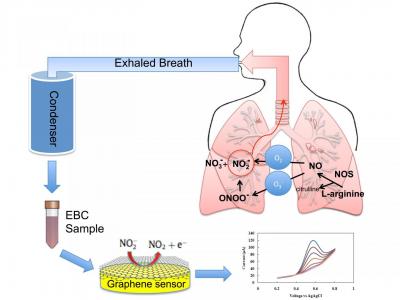Rutgers University scientists have created a graphene-based sensor that could lead to earlier detection of asthma attacks and improve the management respiratory diseases, possibly preventing hospitalizations and deaths.

The Rutgers team aims for the sensor to pave the way for the development of devices - possibly resembling fitness trackers - which people could wear and then know when and at what dosage to take their medication.
Today's non-invasive methods for diagnosing and monitoring asthma are limited in characterizing the nature and degree of airway inflammation, and require expensive and cumbersome equipment that patients cannot easily keep with them. This is why many researchers feel there is a major need for improved, minimally invasive methods for the molecular diagnosis and monitoring of asthma.
Measuring biomarkers in exhaled breath condensate - tiny liquid droplets discharged during breathing - can contribute to understanding asthma at the molecular level and lead to targeted treatment and better disease management. The Rutgers researchers' miniaturized electrochemical sensor accurately measures nitrite in exhaled breath condensate using reduced graphene oxide.
"Nitrite level in breath condensate is a promising biomarker for inflammation in the respiratory tract. Having a rapid, easy method to measure it can help an asthmatic determine if air pollutants are affecting them so they can better manage use of medication and physical activity," said one of the study's co-authors and professor at Rutgers' Environmental and Occupational Health Sciences Institute (EOHSI). "It could also be used in a physician's office and emergency departments to monitor the effectiveness of various anti-inflammatory drugs to optimize treatment". "The ability to perform label-free quantification of nitrite content in exhaled breath condensate in a single step without any sample pre-treatment resolves a key bottleneck to enabling portable asthma management."
The next step is to develop a portable, wearable system, which could be commercially available within five years, the team said. The researchers also envision expanding the number of inflammation biomarkers a device could detect and measure.
Earlier this month, a collaborative project was announced, with aims to develop an innovative graphene-based sensor. The thought is to provide an easy, low-cost method of diagnosing hepatitis on the spot, and the graphene sensor is planned to be the first to simultaneously test for three types of hepatitis A, B and C.